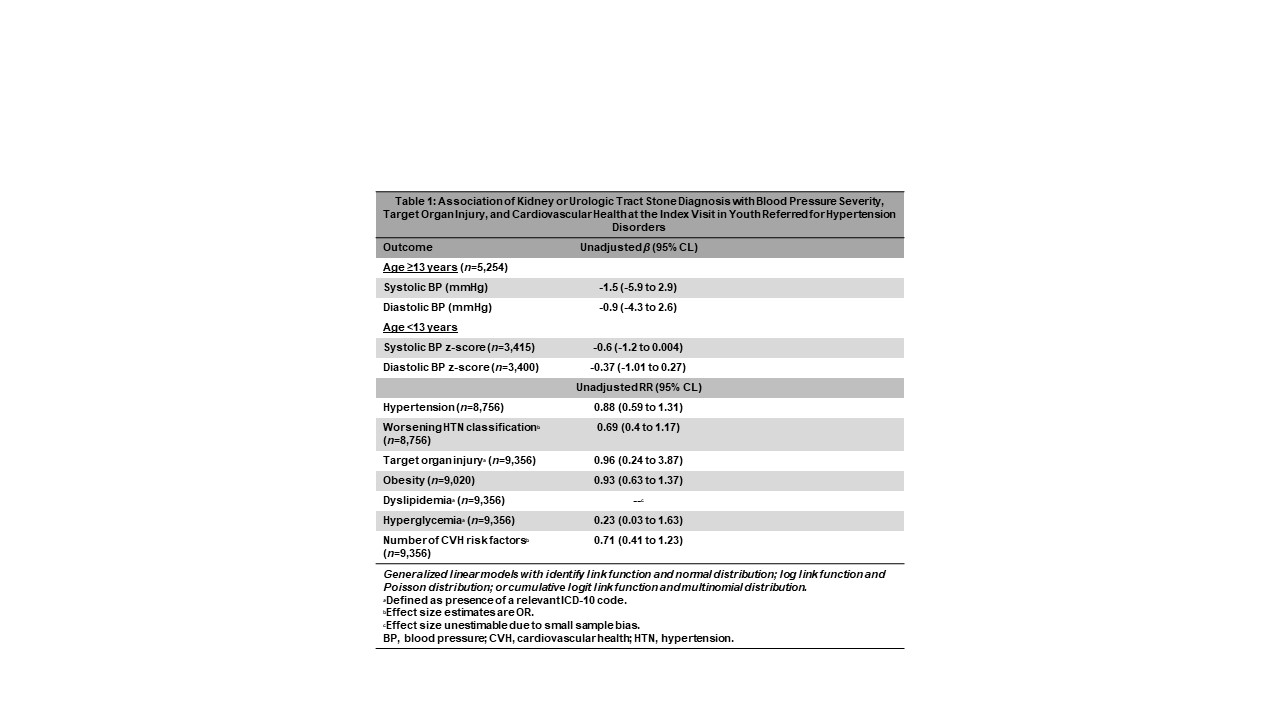Hypertension
Session: Hypertension
034 - Association of Kidney or Urological Tract Stones with Baseline Blood Pressure Severity, Target Organ Injury and Cardiovascular Health: A SUPERHERO Analysis
Saturday, April 26, 2025
2:30pm - 4:45pm HST
Publication Number: 34.3819
Maggie Murphy, University of Kentucky College of Medicine, Lexington, KY, United States; Stefan G. Kiessling, Kentucky Children's Hospital, Lexington, KY, United States; Andrew M. South, Wake Forest School of Medicine of Wake Forest Baptist Medical Center, Winston Salem, NC, United States; Michael J. Walsh, Wake Forest School of Medicine of Wake Forest Baptist Medical Center, Winston-Salem, NC, United States

Margaret Murphy, PhD, RD (she/her/hers)
Assistant Professor/Pediatric Renal Dietitian
University of Kentucky College of Medicine
University of Kentucky Healthcare
Lexington, Kentucky, United States
Presenting Author(s)
Background: The prevalence of youth-onset hypertension (HTN) and kidney and urological tract stones are rising in concert with obesity. It remains unknown if youth with HTN disorders and kidney or urological stones have worse HTN and cardiovascular health.
Objective: Determine if kidney or urological tract stone diagnosis is associated with blood pressure (BP) severity, target organ injury (TOI), and cardiovascular health at baseline in youth with HTN disorders.
Design/Methods: Cross sectional analysis of baseline data from the Study of the Epidemiology of Pediatric Hypertension (SUPERHERO) Registry, a multisite retrospective cohort of youth referred to subspecialty care for hypertension disorders using electronic health record data. Inclusion criteria were an initial subspecialty clinic visit for HTN disorders identified by ICD-10 codes from 1/1/2016–12/31/2023 and age < 19 years. Exclusion criteria were kidney failure on dialysis, kidney transplantation, or pregnancy by ICD-10 codes. Exposure included kidney or urological tract stone diagnosis identified by ICD-10 codes. Unadjusted generalized linear models estimated the association of nephrolithiasis with the outcomes of BP severity with z-scores and classification per US guidelines, obesity by BMI or weight-for-length percentiles, TOI, dyslipidemia, and hyperglycemia by ICD-10 codes.
Results: Of the 9,356 participants, mean age was 12.8 ±4.5, 62% were male, and < 1% (n=43) had kidney or urological stone diagnosis. Participants with kidney or urological tract stone diagnosis were more likely to be male and had lower systolic and diastolic BP. Associations among BP severity, TOI, obesity, hyperglycemia, and number of cardiovascular health risk factors were not observed in participants with kidney or urological tract stone diagnosis (Table 1).
Conclusion(s): In a large multisite cohort of youth referred for HTN disorders, prevalence of kidney or urological stone diagnosis is less than one percent and not associated with BP severity or cardiovascular health. This study suggests that participants with HTN disorders and kidney or urological stone diagnosis do not have worse HTN or cardiovascular health outcomes. A limitation of this study is small sample size. Future studies will include laboratory data, 24-hour urine studies, and echocardiogram data to better inform future management of youth with HTN disorders.
Association of Kidney or Urologic Tract Stone Diagnosis with Blood Pressure Severity, Target Organ Injury, and Cardiovascular Health at the Index Visit in Youth Referred for Hypertension Disorders


